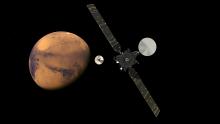Listen to today's episode of StarDate on the web the same day it airs in high-quality streaming audio without any extra ads or announcements. Choose a $8 one-month pass, or listen every day for a year for just $30.
You are here
Mars Returns
While one European spacecraft steps closer to Mars, scientists are narrowing down the list of landing sites for a craft that will step across Mars.
ExoMars Trace Gas Orbiter arrived at Mars last October. But the trip from Earth was just the start of its journey. As planned, it entered a lopsided orbit that’s too high to do its work. So engineers are lowering its orbit. They’re doing so by having the craft drop deeper into Mars’s atmosphere on each lap. That creates drag that pulls the high point of its orbit closer to Mars.
Trace Gas Orbiter will complete the maneuvers in about six months. After that, it’ll start “sniffing” the atmosphere for methane and other compounds that could be produced by living organisms.
In the meantime, scientists are studying landing sites for a rover that will arrive at Mars in 2021. They’ve narrowed it down to two possibilities. One is in a low plain that was filled with water billions of years ago. The other is near the mouth of a valley that may have been filled with water for hundreds of millions of years. Scientists will pick the winning site a year before launch.
And Mars is climbing into view in the dawn twilight right now. It’s quite low in the east, and it’s not very bright yet. But it’s near some brighter bodies. Venus, the “morning star,” is high above it, with the star Regulus a little below Venus. The bright planet Mercury is well below Regulus, with fainter Mars just a whisker away from Mercury.
Script by Damond Benningfield






